A small detail that makes a big difference to your home is the way you build your wood deck. If you are building it from scratch, you might be unsure whether it should have a slope. Look no further, as we have done the research for you in this post!
A wood deck should have a slope. As an outdoor piece of your home, your deck gets exposed to the elements. It should be able to withstand any weather, especially the rain. A sloped deck allows rainwater to run off the sides and prevents it from pooling on your deck.
There's a little more to note when sloping your deck. If you are working on a DIY job, how will you know you are sloping your deck enough? Do feel intimidated by having to do a few computations? It's worth it in the long run. We will go over more details in this post, so read on!
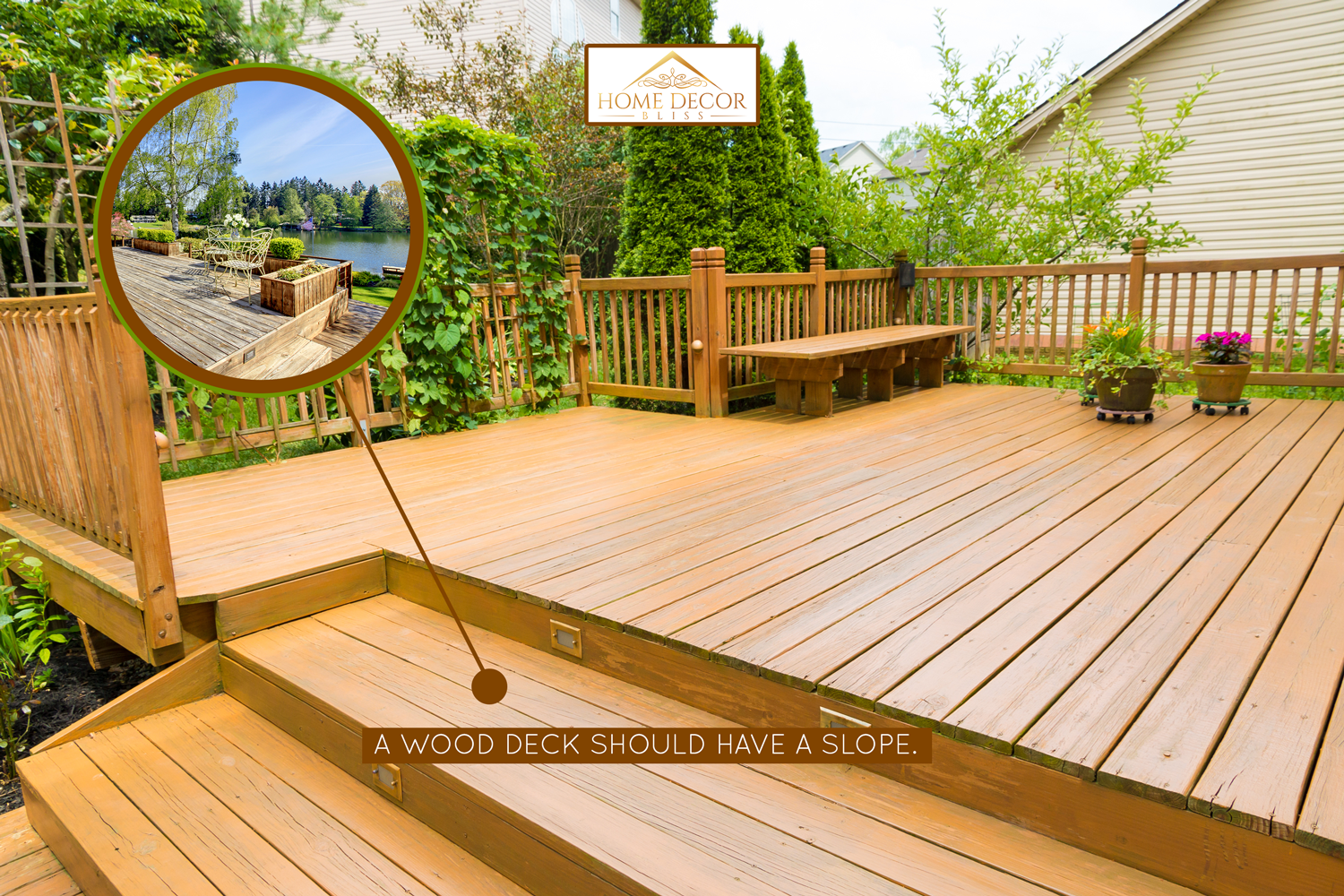
How Much Should You Slope Under A Deck?
Your deck does not need to have a dramatic slope. For every foot on your deck, slope it by at least 1/8th of an inch. Some contractors will slope it by 1/4th of an inch. Whichever increment you choose, it should be enough for water to drain.
A completely level deck that runs parallel to your house may cause pooling or ponding. If your deck doesn't have a slope, then there should at least be large enough gaps between the boards for water to flow. Some decks, however, are solid all throughout.
If you do not want to slope your wood deck, you need to have gaps between the boards. Gaps should be anywhere from 1/4 inch to 3/8 inch to allow water and debris to go through.
How To Calculate Deck Slope From Percentage?

We may include affiliate links and curated AI content to highlight top design styles.
On occasion, you may encounter deck slope percentages. This is to keep the slope consistent regardless of the deck size. You can figure out the elevation difference through this percentage.
A good rule of thumb for calculating your deck slope is to keep it at 1.25% to 2%, depending on your preference. Here is a brief explanation of how these percentages work:
Consider a wood deck that is 10 feet that calls for a 2% slope. You can use a slope calculator to figure this out as long as you have the length of the deck, but the equation is simple enough to do manually:
- Convert the measurement to inches
- Multiply the deck length by the percentage
- The product is equal to the elevation difference in inches
Using our example, 10 feet or 120 inches with a 2% slope would look like this:
120 * (2 / 100)
= 2 and 3/8 inches
The end of the deck drops 2 and 3/8 inches from the house.
You can easily plug this equation into a calculator. Simply replace the measurements and percentage as needed. A couple of sites online also have slope calculators that compute this, so you don't have to.
How High Should Decking Be From The Ground?
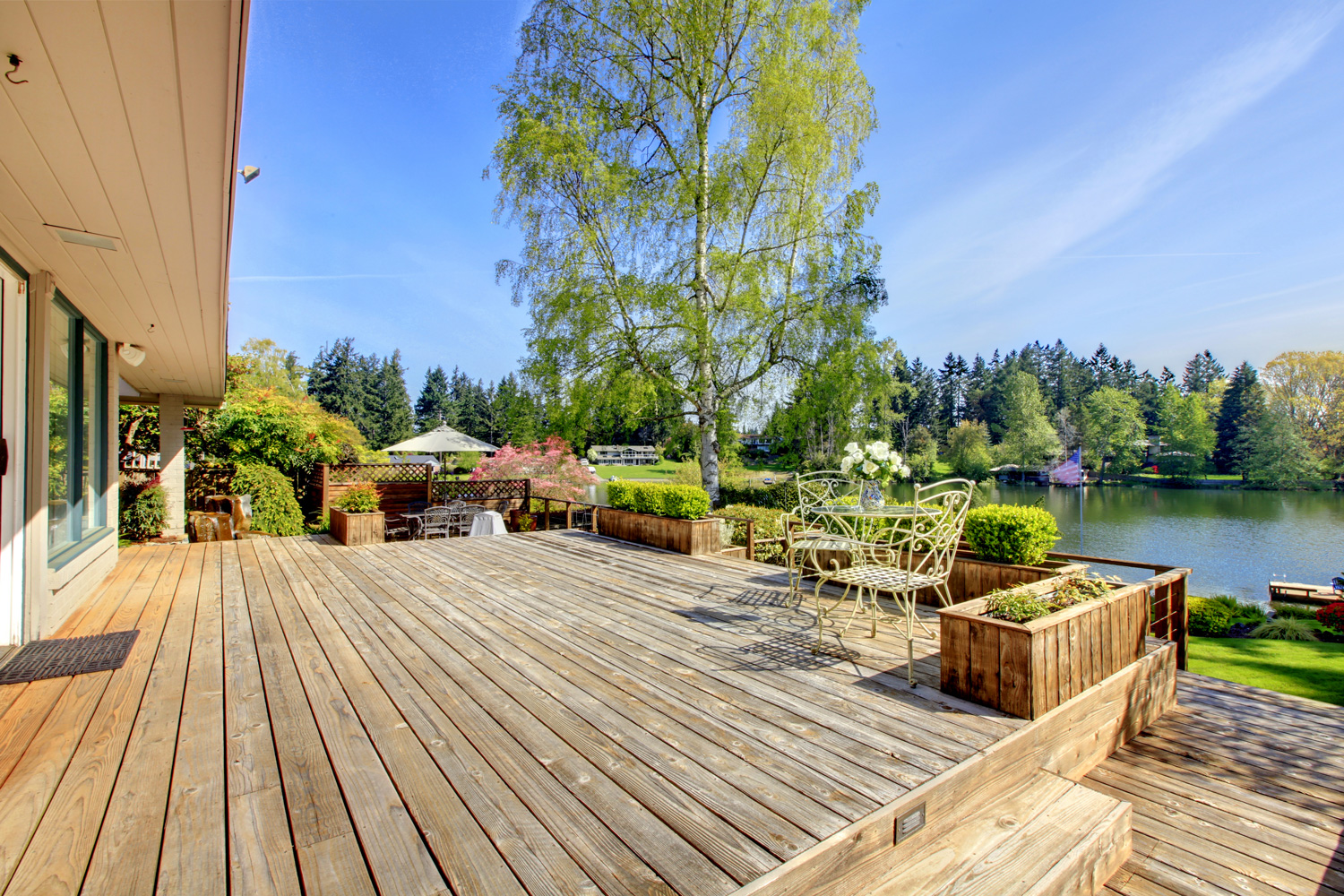
Your wood deck can be at ground level or higher. Ground level decks need proper ventilation underneath, just to allow for decent airflow. Poorly ventilated decks will trap moisture and result in structural damage.
Installing ground-level decks require extra precautions. For instance, by adding gaps between the deck boards. Avoid materials that are too porous and instead opt for hardwoods or deck tiles.
Now, let's say you have limited material or installation options. If you want to avoid water damage and do not know how to ventilate your deck properly, consider raising the deck height.
Different areas have different building codes you need to follow. But in general, decks that are higher up need to have a quad rail with a minimum height of 30 inches from the ground. The rail at this point has to be at least 36 inches tall.
Preparing To DIY Your Deck
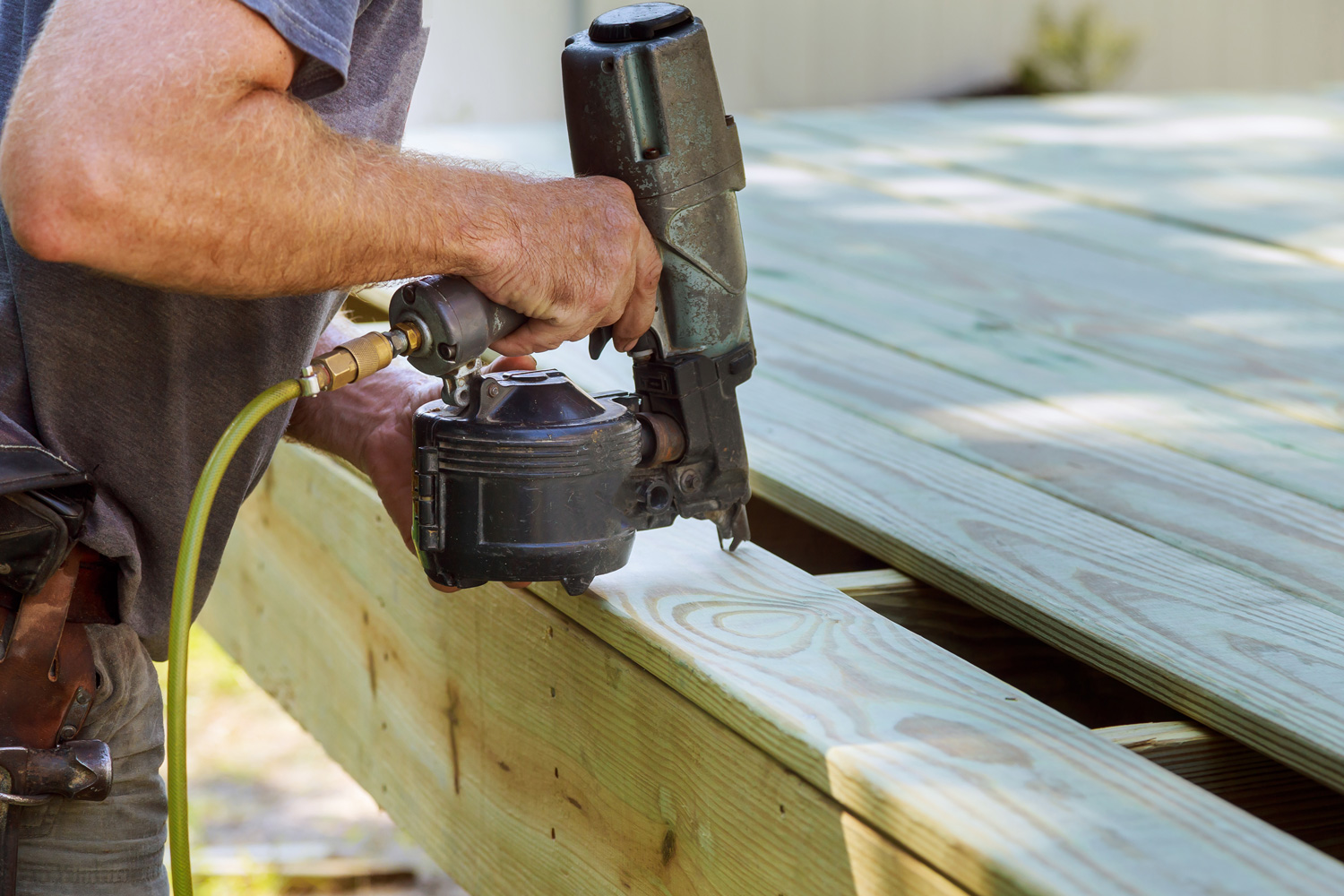
Installing a deck on your own is a big task. This can take a few days, so you have to be properly equipped to handle it. Also, make sure to study and understand your area's building codes before working on a plan.
Once you are sure about your course of action, pick an appropriate material for your deck. Select wood boards made with building in mind. During installation, be mindful to put the boards in the correct direction. Decking boards have a ridge, which should face down.
Laying a decking board ridge side down improves airflow and grip at the same time. This will improve safety and the longevity of your deck. Again, just like any structure, over time moisture can ruin your deck.
Since you are laying your deck boards ridge side down and smooth side up, you can easily paint your deck afterward
When to Paint Your Wood Deck?
Paint or stain your deck during good weather. Some paints, especially latex paints, have a certain temperature requirement to perform properly. If you live somewhere with temperate climates, you could take on this project during the fall.
The fall months are moderate enough for your paints or stains to behave nicely, leaving an easy and clean job. Staining works well in outdoor temperatures between 50F and 90F. Be careful not to stain or paint when there is a risk of rain.
Conversely, avoid direct sunlight. Stain your deck for up to two coats, and wait 24-48 hours between coats. Check which method of application works best for you and follow the product instructions.
How To Maintain A Wood Deck?

We covered a few precautions to keep in mind when building a deck, particularly with wood deck boards. Once your deck is put together, maintain it well.
The most basic maintenance work for your deck is simply to clean it regularly. Sweep debris off the deck to prevent buildup. Keep up to date with repairs, and schedule a deep clean once in a while.
You may have furniture, plants, and other accessories on your deck. Keep these up to date as well. You will want to move them temporarily when you completely clean your deck to avoid any damage.
Should You Seal A Wood Deck
You may consider staining or sealing your deck. You will have to choose one depending on how much protection your deck needs. Different methods also last for varying amounts of time.
Painting your wood deck not only makes it look good but can also provide protection from the elements. Its opacity blocks UV rays, and latex or oil-based paints protect against moisture.
Your deck can benefit from paint if you take care of the preparations and proper application. Do not paint over moist wood. Take note that paint can chip, so it is not as long-lasting compared to sealants and stains.
If you live in a particularly humid or wet place that does not see a lot of sunlight, consider using sealants. They work best against moisture. Sealants do not block UV rays as well as paints or stains, since they are not as pigmented.
Stains are less viscous than sealants and do not offer as much moisture protection. They do, however, protect against UV rays. Stains are pigmented, and you can use a combination of stain and sealant rather than paint.
Of course, make sure your deck is in good condition before you seal, stain, or paint it. Clean or wash the deck, sand it, then vacuum. This way, your sealant can keep a good hold on the wood.
Seal or stain your wood deck annually. Keep a consistent schedule, preferably at the time of year when the weather is clear and dry, but not too sunny. Do not reseal or restain in extreme temperatures.
Click here to see Wood Stain and Sealer on Amazon
Click here to see Exterior Latex Floor Paint on Amazon
Wood Deck Ideas
Wood decks offer a classic touch to your home exterior. Decks are a go-to gathering space for guests or your own relaxation, so it needs to be a pleasant place to stay outdoors.
If you are thinking about building your wood deck or updating the one you already have, check out these photos for inspiration!
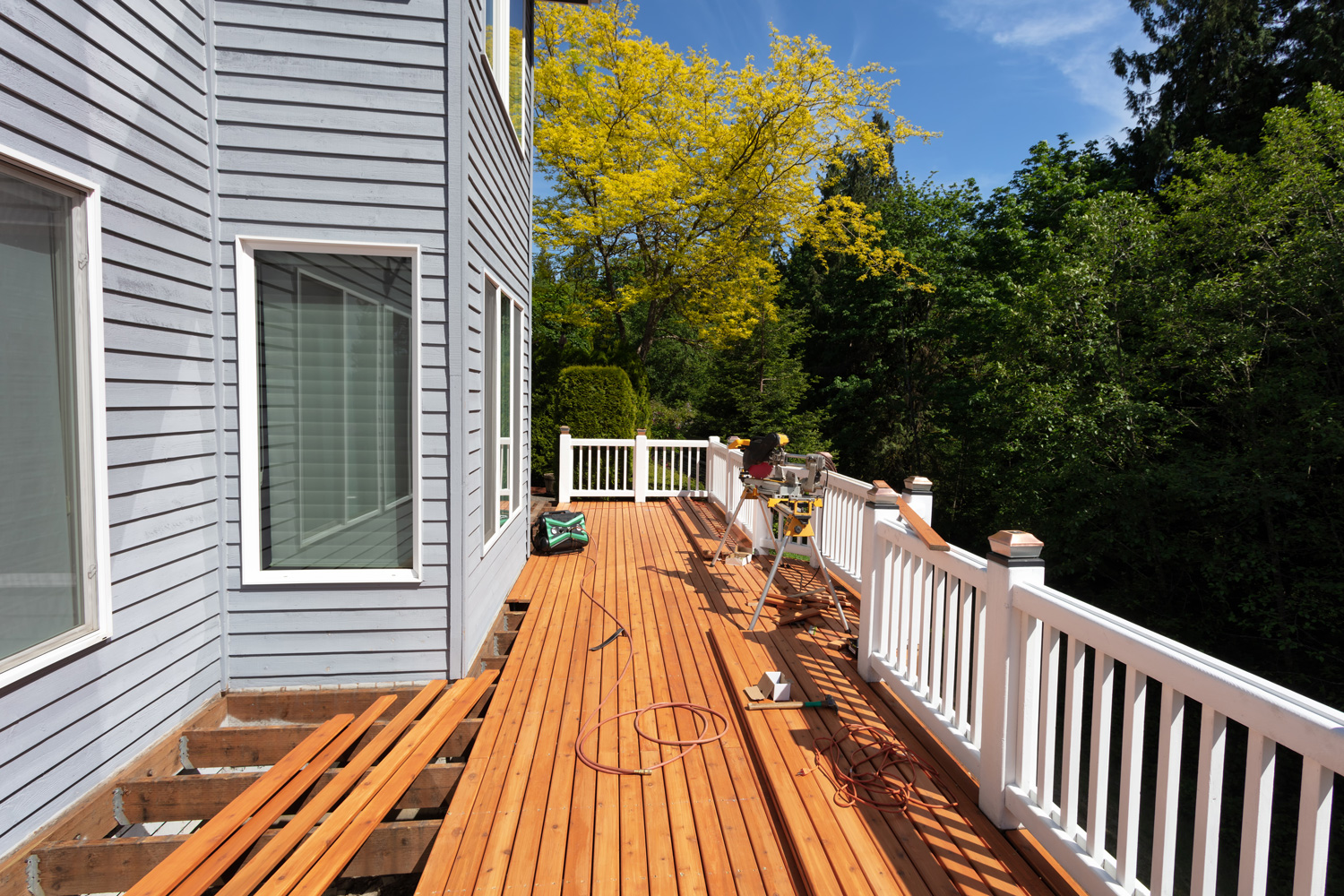
This multi-level deck has a lower part that doubles as seating space. It is perfect for the summer, and since it is meant to be under the sun, opt for a good anti-UV stain.
These cozy decks use a dark stain that matches nicely with potted plants and shrubs.

Notice how each level of this deck slopes down towards the stairs. Debris and water can easily drain off the stairs this way. They can also drain through the gaps between the wood decking.
Wrapping Things Up
Every wood deck needs to have a slope. The building standard usually calls for a slope that is between 1/8 to 1/4 of an inch per foot, or 1-2% of the deck length.
The slope helps maintain your deck and keeps water from pooling onto it. Coupled with a good sealant and proper care, your deck will stay in good condition for a long time.
Did you find this post helpful? If so, consider checking out our other articles:



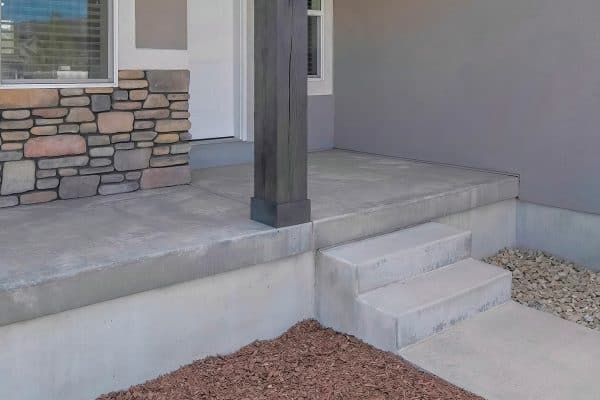
![cement deck block foundation installed on, How To Use Concrete Deck Blocks [A Detailed Guide]](https://homedecorbliss.com/wp-content/uploads/2022/11/cement-deck-block-foundation-installed-on-600x400.jpg)
